The system you're referring to was described briefly in the Bell System Technical Journal in 1935. Most of the article is about measuring the advantages of the (then brand-new) "single-sideband suppressed carrier" (SSB) modulation over the conventional double-sideband amplitude modulation (AM), but it mentions some of the history of transatlantic telephone in passing, and says that it used shortwave frequencies of 5 to 20 MHz (5,000 to 20,000 kc in the notation of the time).
Waves at these frequencies are capable of being refracted by the F-layer of the ionosphere (a layer of charged particles 200 - 400 km above the Earth's surface, which was theorized in the 19th century, but first seriously measured between 1925 and 1927). Refraction of signals by the ionosphere makes it possible to communicate between points on the Earth's surface up to 3,000 - 4,000 km apart in a single "hop". This is just about enough to cover the distance between Newfoundland and England, but it's also possible for a signal to take multiple "hops" — conveniently, seawater makes a good reflector of radio signals.
The relatively wide range of frequencies (a 4:1 ratio) was used because ionospheric conditions vary with time of day, time of year, and the solar cycle — generally, lower frequencies perform better at night, in winter, and during solar minimum, while higher frequencies perform better at midday, in summer, and during solar maximum.
